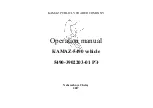
In Case of Submersion
In case of submersion, secondary impact damage can never be excluded. Damaged high-voltage components
pose an increased electrical shock hazard. Stay away from damaged high-voltage components. Handle any
fully or partially submerged vehicle while wearing the appropriate Personal Protection Equipment (PPE).
A submerged vehicle
without
impact damage has a low electrical shock hazard risk. Small bubbles may be
noticed exiting the vehicle. This is due to electrolysis of the water and does not create a higher risk of shock
hazard.
WARNING: To prevent personal injury and / or death, consider the entire vehicle as energized.
Always wear full Personal Protection Equipment (PPE).
WARNING: To prevent personal injury and / or death, pay attention to secondary fire events. There
is a high risk of reignition due to damage and corrosion. Saltwater increases this risk for electrical
shorts post incident.
Keep full Personal Protection Equipment (PPE), including Self-Contained
Breathing Apparatus (SCBA) ready.
WARNING: To prevent personal injury and / or death, avoid any contact with a submerged
high-voltage system.
Do not attempt to disable the Main Battery Disconnect while the vehicle is
submerged. The ignition may be turned OFF.
1.
Turn the ignition OFF (if possible).
2.
Recover the vehicle
3.
Drain the water out of the vehicle
4.
Initiate the deactivation of the Main Battery Disconnect
Towing / Transportation / Storage
Towing
The preferred method is to tow the vehicle with the front wheels suspended. If towed with the rear wheels on
the ground, the drive shaft / propeller shaft must be removed between the drive motor and rear axle.
To improve traffic safety the IC Bus
®
Electric CE Series may be slowly [max 5 mph (8 km/h)] moved anytime
over very short distances. The electric drive motor is connected to the wheels and generates electric voltage
as the wheels are rotated. Higher speed could cause damage to the drive motor, the high-voltage system and
represents a potential hazard.
Transportation
Inform the tow truck driver that reignition is possible at any time with a damaged high-voltage system. If possible,
use a thermal or infrared camera to check whether the battery stacks are cold before towing the truck. To ensure
that electric motor is not rotating, remove the drive shaft / propeller shaft before towing the vehicle to the next
location.
Storage
Damaged vehicles should be isolated outdoors until inspected. Open windows and doors during isolation to
avoid build-up of gases in the compartment. Separate the vehicle from all combustibles and structures by a
distance of at least 50 feet (15 m).
4328785R1
20
© 2021 Navistar, Inc. All rights reserved. All marks are trademarks of their respective owners.
































